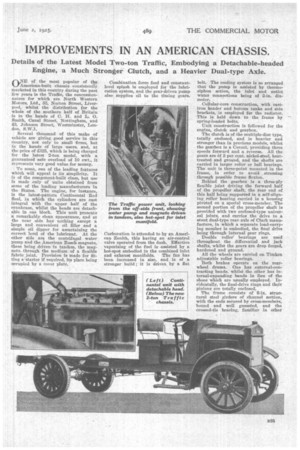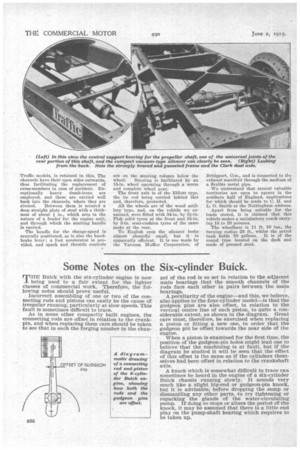IMPROVEMENTS IN AN AMERICAN CHASSIS.
Page 9

Page 10

If you've noticed an error in this article please click here to report it so we can fix it.
Details of the Latest Model Two-ton Traffic, Embodying a Detachable-headed Engine, a Much Stronger Clutch, and a Heavier Dual-type Axle.
fILNE of the most popular of the kJ-American-built chassis consistently marketed in this country during the past few years is the Trafige, the concessionnaires for which are North Western Motors, Ltd., 33, Norton Street, Liverpool, whilst the distribution for the whole of the southern half of Britain is in the hands of C. H. and L. 0. Smith, Canal Street, Nottingham, and 43, Johnson Street, Westminster, London, S.W.1.
Several thousand of this make of vehicle are giving good service in this country, not only to small firms, but in the hands of large users, and, at the price of £325, which is being charged for the latest 2-ton model, with a guaranteed safe overload of 10 cwt., it represents very good value for money.
To some, one of the leading features which will appeal is its simplicity. It is of the component-built class, but use is made only of units obtained from some of the leading manufacturers in the States. The engine, for instance, is the latest-pattern Continental Red Seal, in which the cylinders are cast integral with the upper half of the crankcase, whilst the heads are detachable in one block. This unit presents a remarkably clean appearance, and at the near side has nothing except a large and convenient oil filler and a simple oil dipper for ascertaining the correct level of the lubricant. At the other side are the centrifugal water pump and the American Bosch magneto, these being driven in tandem, the magneto through the medium of a flexible fabric joint. Provision is made for .fitting a starter if required, its place being occupied by a cover plate.
Combination force feed and constantlevel splash is employed for the lubrication system, and the gear-driven pump alsol supplies oil to the timing gears.
Carburation is attended to by an American Zenith, this having an air-control valve operated from the dash. Effective vaporizing of the fuel is assisted by a hot-spot embodied in the combined inlet and exha.ust manifolds. The fan has been increased in size, and is of a stronger build ; it is driven by a flat belt. The cooling system is so arranged that the pump is assisted by thermosiphon action, the inlet and outlet water connections being of 2-in. diameter.
Cellular-core construction, with castiron header and bottom tanks and side brackets, is employed for the radiator. This is held down to the frame by spring-loaded bolts.
Unit construction is followed for the engine, clutch and gearbox.
The clutch is of the multiple-disc type, totally enclosed, and is heavier and stronger than in previous models, whilst the gearbox is a Covert, providing three speeds forward and a reverse. All the gears are of 3 per cent, nickel-steel, heattreated and ground, and the shafts are carried in larger roller or ball bearings. The unit is three-point mounted in the frame, in order to avoid stressing through possible frame flexion.
Behind the gearbox is a three-ply flexible joint driving the forward half of the propeller shaft, the rear end of this half being supported in a self-aliguing roller bearing carried in a housing pivoted on a special cross-member. The second portion of the propeller shaft is provided with two enclosed-type universal joints, and carries the drive to a frtont dual-type rear axle of Clark manufacture, in which a separate load-carrying member is embodied, the final drive being through internal gear rings.
Double roller' bearings are used throughout the differential and jack shafts, whilst the gears are drop forged, hardened and ground.
All the wheels are carried on Timken adjustable roller bearings.
Both brakes operate on the rearwheel drums. One has external-contracting bands, whilst the other has internal-expanding bands in lien of the shoes which are usually employed. Incidentally, the final-drive rings and their pinions are totally enclosed.
The frame consists of 6-in. fArnetural steel girders of channel section, with the ends secured by cross-members, bound and well gusseted, and the crossed-tie bracing, familiar in other
Traffic models, is retained in this. The channels have their open sides outwards, thus facilitating the replacement of cross-members in case of accident. Exceptionally heavy dumb-irons are employed, and these are carried well back into the channels where they are
riveted. Between them is secured a deep straight plate of steel with a thickness of about in., which acts in the nature of a fender for the engine unit, and through which the starting handle is carried.
The handle for the change-speed is centrally positioned, as is also the handbrake lever ; a foot accelerator is provided, and spark and throttle controls are on the steering column below the wheel. Steering is facilitated by an 18-in, wheel operating through a worm and complete wheel gear.
The front axle is of the Elliott type, the tie rod being carried behind this and, therefore, protected.
All the wheels are of the wood artillery type, and, on the vehicle we examined, were fitted with 34-in. by 3i-in. Fisk solid tyres at the front and 34-in. by 5-in, semi-cushion tyres of the same make at the rear.
To English eyes the silencer looks almost absurdly small, but it is apparently efficient. It is one made by the Vacuum Muffler Corporation, of Bridgport, Con., and is connected to the exhaust manifold through the medium of a flexible metal pipe.
We understand that several valuable territories are open to agents in the southern half of England, applications for which should be wade to C. H. and L. 0. Smith at the Nottingham address.
Apart from being suitable for the loads stated, it is claimed that this vehicle makes a satisfactory coach carrying 18 to 20 persons. The wheelbase is 11 ft. 10 ins., the turning radius 28 ft., whilst the petrol tank holds 10 gallons. It is of the round type located on the dash and made of pressed steel.




























